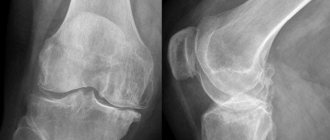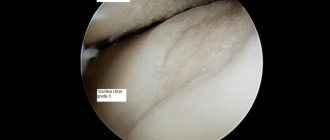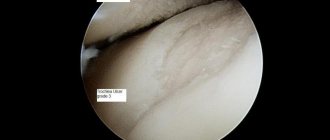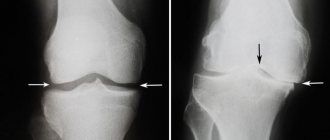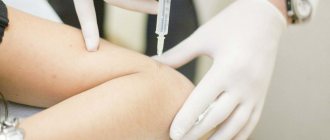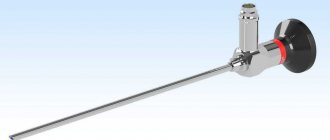It’s downright difficult to get in line at a hospital for knee replacement for free. The surgical intervention itself costs a lot of money - at least fifty thousand rubles (plus a prosthesis!), and it’s a rare family in our country that can afford it. The state program makes it possible for some people in need to receive services without financial compensation, but to do this they will have to collect the necessary documents confirming the need for surgery, take tests and wait their turn. There are restrictions on the number of people accepted into the government program each year. How to be among the lucky ones?
General overview
The cost of knee replacement is currently quite high - from 50,000 rubles only for the intervention itself, and, in addition, you will have to pay for the hospital stay, the medications used, all the studies that will be carried out, as well as the prosthesis. Many believe that the intervention is worth the money, because we are talking about an operation in which the damaged parts of the knee are successfully restored, and the person is able to move normally. The question is extremely relevant; many of our compatriots suffer from knee problems. For others, the cause is injury, for others it is age-related changes that have destroyed the joint tissue.
By waiting your turn under the quota for knee surgery, you can count on full compensation for the money spent on surgery or a partial refund of the amount. As can be seen from the responses of people who managed to get into the program, such an intervention restores the quality of life, and the state program gives hope to those whose financial capabilities would never allow them to accumulate such a significant amount on their own.
In what cases can a quota for joint surgery be issued (free endoprosthetics)
The following pathologies are indications for quotas:
- Diseases of the knee joint ligaments;
- Oncological diseases that impair the functioning of the patient’s musculoskeletal system;
- Pathologies resulting from systemic diseases and affecting connective tissue;
- Defects that manifested themselves in the postoperative period after a certain time after endoprosthetics;
- A complex of consequences of injuries (surgeries) and arthrosis, accompanied by deformation;
- von Willebrand's disease;
- Pathologies resulting from blood clotting disorders;
- Contraindications to treatment other than endoprosthetics;
- Infectious diseases affecting the location of the prosthesis;
- Problems with the functioning of the implant - wear, abrasion, loosening, etc.;
- Errors and inaccuracies associated with the installation of a prosthesis;
- Bone fracture in the immediate vicinity of the implant.
When knee and hip replacement surgery is not subject to quota
In some cases, endoprosthetics are not subject to quotas. First of all, we are talking about such contraindications to surgery as:
- Excessive bone fragility;
- Nerve ending defects;
- Underdevelopment of bone tissue;
- Rheumatoid arthritis;
- A number of diseases of the cardiovascular system;
- Osteoporosis;
- Infectious foci in the body;
- Purulent lesions;
- Acute pathologies of the extremities.
There are other points due to which a person in need of endoprosthetics is not subject to quotas. If they occur, then the patient has two options to help save money.
- Seek treatment from a government medical institution. This way you won’t have to pay for the services of medical staff, although the purchase of most consumables (including a prosthesis) will fall on the patient’s shoulders.
- Become a participant in a program called IPR - an individual rehabilitation plan. It will be discussed below.
How much does joint surgery (endoprosthetics) cost?
Treatment through endoprosthetics is a very expensive procedure and not always affordable for families with average incomes. Approximate prices (which, of course, can vary within fairly wide limits) are given in the table.
| Name of service | approximate cost | Explanations |
| Joint replacement surgery | 50,000 rubles | Depends on the chosen medical institution, the qualifications of the doctor, the drugs and instruments used. |
| Purchasing an implant | From 25,000 rubles (the cheapest domestic version of an artificial element of the knee joint) to 300,000 rubles and above. The cost of knee and hip replacements varies widely. | The price depends on the material used to make the implant (which, in turn, affects service life and comfort), its design, and manufacturer. |
What to do?
Perhaps the most pressing question is how to apply for a quota for knee replacement. Bureaucracy in our country is one of the important enemies, and we have to fight it almost every day, especially in a situation when it comes to medical services. The legislation establishes a list of sequential actions that allow you to gain access to the desired program. It all starts with a full medical examination at the place of residence. The doctor’s task is to correctly complete the documentation and write a conclusion indicating the need for knee replacement. Based on such paper, you can already count on being included in the queue.
The documentation on the basis of which knee replacement is performed involves providing the medical institution with not only a medical opinion, but also a statement written personally by the patient, as well as transferring a copy of the passport, insurance policy, and identification number. It will be necessary to conclude an agreement with the institution. If a person has disabled status, a document confirming this fact must be provided.
Appearances and passwords
The described documents must first be submitted to a commission assembled by local government agencies responsible for healthcare and social protection of the population. The participants’ task is to determine to what extent a person needs urgent knee replacement and whether he should be given access to the program under a quota. The duration of the case consideration is 10 days. If the outcome is positive, the documentation is automatically redirected to the clinic responsible for providing the appropriate medical class=”aligncenter” width=”700″ height=”486″[/img]
The next stage of paperwork is the responsibility of the medical institution. Clinic managers study the received documentation and then decide how long to wait for the knee replacement quota. The facility usually already has a waiting list of patients who need such intervention. Data on a new person is analyzed to understand which date will be optimal for him. As the decision is made, information about it is officially transferred to the medical commission, which notifies the citizen who has requested help about when and where endoprosthetics will be performed, and what additional measures need to be taken to prepare for the intervention.
So, where are knee replacements done on a quota basis? Medical institutions in Moscow are listed below:
- City Clinical Hospital No. 67.
- KB MSMU im. Sechenov.
- Hospital named after N. Semashko.
- Medical and Surgical Center named after. N. Pirogova
Current questions and answers
- Question:
How much will the operation cost on average if you pay yourself?Answer:
Endoprosthetics costs about 210-300 thousand.
- Question:
Instead of sending me to the clinic for quota surgery, they prescribe endlessly new examinations. That my new leg will grow? If I refuse these procedures, what will happen?Answer:
If you refuse medical indications, including diagnostics, you will be denied your quota, with no options.
- Question:
In which medical institutions can recovery be carried out?Answer:
The list can include both state regional centers and institutes, and private clinics. Check the list for your region.
- home
- Social benefits
- Benefits for disabled people
Article rating:
(votes: 4 , average rating: 3.25 out of 5)
Share with friends:
Popular material
About the timing. Who should
The laws establish that the waiting time in line is about a quarter of a year. In reality, the period increases significantly due to the high demand for participation in this program.
Currently, knee joint replacement is a quota for adults, children, and patients with cancer that negatively affects the capabilities of the musculoskeletal system. A person who is suffering from severe pain, and conservative treatment methods do not show effectiveness, can contact a medical commission. Those who have already received a prosthesis, but it has worn out or collapsed completely or partially, have certain opportunities. You should also try to get in line if a prosthesis was previously placed, but this area is inflamed.
There are certain opportunities for knee replacement under a quota for those who have suffered a fracture or experienced unsuccessful surgery. If the situation is complicated by rheumatism, arthrosis and other similar pathologies, or the limbs are subject to destructive changes, you should try to submit documents to be included in the queue.
When is a hip replacement necessary?
Indications for hip replacement are:
- Arthrosis;
- Wear and tear of the joint during life;
- Injuries;
- Congenital features of joint development;
- Inflammatory processes.
Arthrosis is the most common reason for surgery. In case of damage to the hip joint, they speak of coxarthrosis. This condition represents changes of a degenerative-destructive nature, in which cartilage is destroyed, bone surfaces are deprived of their protective layer and are deformed. The discrepancy between the load and the capabilities of the affected joint leads to worsening changes, pain and limited mobility. Cartilage tissue is not able to recover, and the process is irreversible. Osteoarthritis is promoted by chronic injuries and malnutrition of the joint.
Wear and tear of the hip joint occurs in old age due to overload with movement, body weight, and heavy lifting. Over time, the nutrition of the joint elements is disrupted, the cartilage becomes more fragile and brittle, and the joint ceases to play the role of a shock absorber. In such cases they talk about “age-related wear.”
Trauma is also a common cause of hip dysfunction. Injuries in this area often result in a fracture of the femoral neck, which is considered a common pathology of the musculoskeletal system in older people. Elderly women, who suffer from osteoporosis and brittle bones due to age-related hormonal changes, are especially susceptible to hip fractures.
Already existing in old age, secondary changes in articular elements, impaired nutrition of cartilage and bone tissue lead to the fact that the fusion of bone fragments is almost impossible. Patients are forced to lie down, and walking is out of the question. Such bed rest is in many ways more dangerous than the fracture itself, since it contributes to the exacerbation of chronic pathology of the lungs, heart and blood vessels. Bedridden patients after a hip fracture have an increased risk of stroke, thromboembolic complications, bedsores, and pneumonia are likely, so they need hip replacement surgery. It allows not only to avoid serious complications, but also to save the patient’s life.
In the case of other injuries accompanied by damage to the ligamentous apparatus, cartilage tears, dislocations, post-traumatic coxarthrosis is a frequent consequence, which necessitates surgical treatment.
If the formation of a joint is disrupted in the prenatal period or early childhood (dysplasia, congenital dislocation), trophic disorders and degeneration of the osteochondral base are inevitable. Early arthrosis develops, pain appears, and movements become difficult.
Inflammatory processes can be caused by rheumatoid arthritis, gout, systemic connective tissue diseases, and injuries. All of them lead to destruction of articular elements and the need to replace them with artificial ones.
Other reasons why endoprosthesis replacement is necessary include aseptic necrosis of the femoral head due to closure of the feeding arteries, excessive load on the joint due to obesity, trophic disorders due to diabetes mellitus and other metabolic diseases.
Is it possible or not?
In some cases, knee replacement is not carried out under a quota (or without it, on a general basis). This applies to situations where doctors identify contraindications to intervention. In particular, a ban on surgery is established for patients suffering from cardiac disorders or vascular diseases, problems with the functioning of the nervous system. Surgery should not be performed on a person with diabetes.
In some cases, the indications are absolute, sometimes temporary. In each individual option, doctors tell you exactly why knee replacement is currently not possible under the quota, and also tell you whether the condition will change over time. There is a possibility that the operation will be allowed once the person’s position has stabilized, when the risk of negative outcomes is reduced. A good example: when blood glucose levels are stabilized in diabetes mellitus, surgery can be performed.
Quota for knee replacement: how to get a quota for surgery (step-by-step instructions)
To exercise your right to receive a quota, you will have to take a number of actions and go through the following stages.
- Contact your doctor. The orthopedic traumatologist, who is registered with a person in need of surgery, issues a referral to a first-level commission based on the medical record data (records in it about tests, examinations and examinations of the patient).
- Commission at the clinic. Each medical institution creates its own regulatory body, which is responsible for such issues. Within a maximum of 10 days, specialists generate a protocol that contains data on the diagnosis and condition of the patient, as well as recommendations for his treatment.
- Formation of a package of documents. If the applicant has no contraindications, his application with the attached documents (the full list will be below) is sent to the regional health care institution.
- Regional commission. The specialists at this level always include an orthopedic surgeon. The patient’s immediate appearance is not required (only in case of controversial issues). Any decision made is recorded. If the verdict is positive, then the completed package of papers, along with a copy of the protocol and a coupon, is sent to the hospital where the medical intervention will be performed. The decision is made on the 10th day maximum.
- The application is reviewed by the medical institution selected to perform the surgical intervention.
What about the money?
According to reviews, knee replacement is an operation for which it is not easy to calculate how large the costs will be. This largely depends on the hospital chosen by the medical commission. If this is a government agency, then in most cases payment is due only for the prosthesis installed on the patient. If the choice fell on a private owner, then you need to pay for the intervention, and for the drugs and prosthesis used, and for being in the ward. Often the amount depends on the qualifications of the doctor performing the intervention.
Another important point related to financial aspects mentioned in reviews of knee replacement: the price of the prostheses used by doctors varies quite a lot. If this product is made in our country, it will cost relatively cheap, but imported models are many times more expensive. Additionally, the increase in price may be explained by special types of examination, if any are prescribed to the patient.
Cost of endoprosthetics
The period after endoprosthetics, as well as the prosthesis itself, is expensive for the patient. Even if the operation is performed in a public clinic, and the staff’s work is covered by the policy, you will have to pay for the material. The total cost of the operation depends on the following factors:
- Type of institution. In state complexes, the policy covers expenses such as:
- operation;
- nutrition;
- hospital stay;
- remedies for pain relief.
- Type of prosthesis and manufacturer. Ceramic and metal products (from 170 thousand) are more expensive than metal-polyethylene composition (from 130 thousand). A cement product will cost the patient up to 120-140 thousand. The cost without cement structures increases by 50 thousand more.
- Type of transaction:
restoration of only cartilage tissue (superficial), as well as partial replacement, costs half as much as total prosthetics (full replacement); the cost of treatment of the hip joint - the most expensive manipulation is 5-7 thousand more expensive than the restoration of the shoulder joint and 10-15 thousand more expensive than the knee joint. Diagnostics. It all depends on the number of diagnostic measures prescribed. They have to be undergone in private clinics, which increases the final cost of endoprosthetics.
Reader reviews about knee replacement allow us to summarize that it is difficult to obtain a quota for the operation, but it is possible. You need to prepare that the entire registration procedure will take about three months. Complications can be avoided if you strictly follow medical advice and instructions.
Will I be on the list?
Currently, the quota program involves providing the opportunity to receive relatively inexpensive medical care only to a strictly limited number of patients. From year to year, more and more people are turning to medical institutions in need of urgent surgery, but only a small percentage receive access to the state program.
Usually quotas are distributed at the beginning of the year. If the request, for example, to replace the meniscus of the knee joint was later, you will have to wait. As a rule, this drags on for a long time. There is a possibility that someone who has already been allocated a quota will refuse the operation. This doesn't happen often, but it is possible. Such an event somewhat shortens the waiting period for those who are in line after the refusenik.
Individual rehabilitation program
In addition to the above options for receiving medical care under a quota, there is also an additional option for installing an endoprosthesis, called an “individual rehabilitation program.” The above program has a number of advantages, which include, for example, the following:
- The opportunity to receive medical care in the largest leading clinics, in which only highly qualified specialists with extensive practical experience carry out activities.
- The program includes costs not only for the operation itself, but also for rehabilitation after endoprosthetics.
- According to the rules of the rehabilitation program, only high-quality endoprostheses manufactured abroad are used for prosthetics.
The main features of the rehabilitation program are the following aspects: the opportunity to obtain such a quota is provided to a limited number of citizens.
In addition, the program does not directly provide payment for the operation performed. According to the rules, a citizen must independently pay for medical services, after which all money spent is returned in full after he undergoes comprehensive treatment.
If you find an error, please select a piece of text and press Ctrl+Enter. We will definitely fix it, and you will get + to karma
What to do?
Two aspects are quite relevant for many: deadlines and which knee joints are placed according to the quota. The first one is clear: not everyone has the opportunity to wait their turn. If the approximate waiting period is years, during this time organic tissues can be destroyed very much, and the person himself will completely lose the ability to move. In such a situation, many try to find an alternative option, looking for funds to pay for the operation themselves. Timely medical care significantly increases the chances of restoring quality of life.
The second aspect is related to the prostheses that will be installed. It is usually assumed that those who go to the clinic at their own expense have a choice. People who get an appointment under a quota can only rely on those prostheses that are currently available in the institution. Of course, this is in any case better than nothing, especially for patients who objectively do not have the opportunity to pay for an operation that allows them to choose what and how to perform it. At the same time, no one can guarantee that at the right time, the doctors of the institution will actually have the best and most modern prostheses.
Where can I read it?
To find out the current legal standards regarding the issue under consideration, you should study the order issued in 2013 by the Ministry of Health, issued under number 565n. It indicates all the features of the provision of quotas, as well as a list of persons eligible to participate in the program. Additional official information is also contained in the government decree issued a year later. This document was published under number 1273. It also discusses the features of inclusion in the waiting list, possible diagnoses with which you can get to the clinic for free (or partially free).
How to save money?
If you cannot find out for yourself how knee replacement surgery works under a quota, and you need to carry out the event entirely at your own expense, you can take advantage of several opportunities to reduce the cost of the event. The cheapest way available to our compatriots is to go to a state surgical clinic. In this case, you will not have to pay for hospital and surgical services - these amounts are covered by an insurance policy, which all citizens of the country must have. But the cost of the prosthesis will have to be reimbursed.
Sometimes the situation develops in such a way that the operation is required very urgently, and the person simply does not have the opportunity to collect all the documentation required by the rules. A public clinic does not always have the right to admit such a patient, so there is a high risk of refusing free care. If the circumstances are this way, the only option is to use the services of a private organization, where you will have to pay both the price of the prosthesis and the costs of the operation.
Algorithm for obtaining a quota for joint surgery in 2021
Let's take a closer look at the algorithm for issuing quotas for endoprosthetics, which is in effect this year.
Conditions for inclusion in the program for obtaining a quota for joint surgery
State support is provided to citizens who, by submitting certain documents, prove the need to receive such assistance. In particular, such papers include:
- Compulsory medical insurance policy;
- Papers confirming an application for medical care for an illness covered by quotas;
- Extracts from the medical record and certificates that track the progress of the disease.
It is recommended to monitor the process of completing the document package by the medical institution in which the quota applicant is registered. Since the carelessness of the clinic staff, which could subsequently lead to a refusal of state support, is not excluded.
Algorithm for obtaining a quota for joint surgery
The feasibility of quotas for a specific patient is determined by the clinic where the patient is observed. This means that to receive state support you should go to the medical institution where the applicant is registered. Each state clinic has created a body whose competence includes issues related to the consideration of quotas. In particular, this commission will examine the following points:
- Results of the general survey;
- Conclusions of narrow specialists (orthopedists);
- Medical history;
- Examination results: tests, pictures, etc.
How to get a quota coupon for joint surgery
The next step is to contact the government agency. It is at this level that quota coupons are issued. In this case, you need to prepare a number of copies and originals of documents. Here is an approximate list of them.
Copies:
- Passport pages;
- Compulsory medical insurance policy;
- Pension certificate;
- Disability certificate;
- A conclusion that clearly confirms the need for endoprosthetics (it contains information about the state of health of the quota recipient, the diagnostic measures performed and their results).
Originals:
- Referral from the orthopedic doctor who is seeing the patient in the clinic;
- Protocol of the commission with a positive decision on the quota;
- Application for a quota from a patient.
All these copies and originals are sent to the health department. Moreover, his authorized representative can do this for the quota recipient.
Deadlines for assigning a quota for joint surgery
To roughly understand how long a patient will have to wait for state-funded medical care, you need to know the approximate timing of each stage of receiving a quota:
- An application submitted to a state-level body is considered within a maximum of 10 days;
- If the verdict is positive, the documents are sent to the medical institution where the operation will be performed;
- The commission dealing with quotas at this clinic determines the date of medical procedures and notifies the health department about this;
- The specialist of the state body informs the quota recipient about the decision made.
In practice, patients have to wait for hospitalization for quite a long time - from 3 months to a year or more.
Disability and some features
The rehabilitation program after knee replacement, in accordance with current legislation, is intended for patients who have become disabled precisely due to the disease for which they were referred for prosthetics. IPR allows you to somewhat reduce the financial costs associated with surgery. The federal budget undertakes to reimburse the cost of prostheses if they were secured by rights that came into force before the beginning of 2015. It does not matter in what year the intervention itself will be carried out - in 2021 or later. True, there is a subtle point: the budget is ready to provide only 160,000 rubles, if the price of the prosthesis is higher, you will have to pay extra yourself.
If the patient entered the rehabilitation program after knee replacement after the end of 2014, then the prostheses are installed in accordance with the Compulsory Medical Insurance, and are guided by the decree issued under number 1776, signed by the government of the country. It provides a complete list of funds that the budget can provide to disabled people, and endoprostheses are not included in it. Using the IPR, you can get access to other rehabilitation devices - crutches, personal hygiene products, etc. At the same time, lawyers point out that many aspects are still not clearly regulated by laws, so it is likely that at the stage of reimbursement of expenses you will have to make a lot of effort to defend your interests.
Price of prosthetics in Russia and abroad
Surgery in such a country will cost an order of magnitude more than in St. Petersburg. The cost without rehabilitation can reach $25,000.
Treatment in centers in Germany is no less popular. Orthopedic departments are equipped with unique equipment and employ only leading specialists. The country's medicine is known for its state-run medical institutions, where the quality of surgery is not inferior to private clinics.
All clinics in Germany provide a guarantee for the prosthesis for 20 years or more, provided that it is used correctly and follows all the doctor’s recommendations.
The tariff will be calculated according to DRG (hospital inpatient pricing). The exact amount will include several prices - surgery, implant, hospital stay. In general, you will have to pay from 7,500 euros. The remuneration for the work of doctors will be calculated separately - from 2,500 euros. Further, mandatory examination starts from 900 euros and additional costs start from 500 euros. The minimum amount that will have to be paid is more than 11,000 euros. This does not include visiting a rehabilitation center - only primary recovery.
Recently, centers in the Czech Republic have become popular with the possibility of further rehabilitation at resorts without leaving the country. In the Czech Republic there is a huge selection of rehabilitation centers aimed at restoring patients after diseases of the musculoskeletal system.
Technical capabilities, qualifications of doctors, and quality of medical services are not inferior to Germany or Israel. In some aspects it even has advantages:
The Czech Republic is a leader in prosthetics; for more than 30 years it was the only country producing endoprostheses; Every year more than 10,000 operations are performed in the country, the success rate of which is 98%; The quality of surgery far outweighs the price. The cost of surgery will be at least 35% lower than in other countries; high level of qualifications of rehabilitation specialists
Czech doctors focus on the recovery period and directly tell the patient that a good operation does not guarantee a complete recovery.
Pricing in the Czech Republic is much more flexible compared to other European centers. There is no need to pay extra: the price of the operation includes the stay and the implantation structure.
The patient is provided with an initial rehabilitation course, which lasts on average two weeks, but classes will be carried out in full. Next, rehabilitators will provide a detailed scheme for further recovery at home.
The popularity of treatment in Europe is due to different standards of medicine, higher and more innovative. This is especially evident in orthopedic surgery. Thus, in Russia, minimally invasive intervention for joint replacement is not used, since there are no technical possibilities. But it is precisely this that eliminates the development of an infectious process and high blood loss.
Therefore, the question remains: get treatment at a high price and be confident in the outcome of prosthetics, or choose a less expensive treatment method that will not give any guarantee.
What's in the future?
The prices are, of course, terrifying, but there is one aspect that scares many even more: the service life of the prosthesis. Modern systems are not eternal help. As the years pass, they gradually deteriorate. The service life is determined by several parameters. One of the most important is the method of attaching the artificial system to bone tissue. In some cases, the components of the prosthesis are literally driven into the bone, and gradually the objects grow together. In medicine this is called osseointegration. When using this technique, the joint elements are firmly fixed, so the system will last quite a long time.
This technique is not always feasible. Often, the quality of the bone simply does not allow for such prosthetics, but there may be other reasons. An alternative option is the use of bone cement, that is, a hardening mass that allows you to quickly fix the prosthesis.
Indications for endoprosthetics in St. Petersburg
Degeneration of the joints of the extremities cannot be treated conservatively even if desired, since damaged articular surfaces are not capable of regeneration.
Conservative tactics are advisable at stages 1 and 2 of coxarthrosis, that is, to a certain extent they can prevent the rapid destruction of the remaining viable cartilaginous tissues lining the head and glenoid cavity of a large joint. At the penultimate and final stage, this is impossible to achieve, since there is practically nothing left of the cartilage, and there is nothing left to save. Due to the critical narrowing of the interarticular space due to the loss of cartilage and exposure of the interacting articular surfaces at 3-4 degrees. The process of bone deformation is in full swing. This clinical picture can be corrected purely surgically using appropriate implantation technology.
St. Petersburg orthopedists, like specialists around the world, recommend endoprosthetics for stages 3-4 of coxarthrosis. However, this is not the only indication for it. Let's look at the entire list of recommendations. The need to remove the original joint and implant in its place the same organ, but fully working and made from artificial materials, arises under the following conditions:
- long-term lack of effect from conservative therapy;
- arthrosis in the stage of maximum joint destruction;
- rheumatoid arthritis (with rheumatoid pathology, prosthetics can be prescribed already at stage 2);
- joint damage due to ankylosing spondylitis;
- aseptic necrosis of the articular bone;
- grade 3 congenital dysplasia in an adult patient;
- femoral neck fracture;
- pseudarthrosis and false joint;
- non-united or improperly healed intra-articular fractures;
- post-traumatic deformations of articular surfaces;
- some types of osteoarticular oncologies;
- the need for revision intervention if problems arise after primary joint replacement surgery.
An emergency indication for this operation in St. Petersburg is a fracture of the femoral neck, since this type of injury can lead to the death of the patient or irreparable congestive and atrophic complications in just a few days. For other indications, the procedure is usually performed as planned.
Friction pair
This parameter of the prosthesis directly determines the length of its service life and the effect on the patient’s organic tissues. In fact, a joint is a joint whose components rub against each other. If in technology the process is smoothed out by the presence of lubricant, then in the human body there is none, so the components wear out significantly over time. The degree of wear is directly related to the survival of the joint. It is determined by the materials used and the number of movements made by a person.
In order for the joint to live longer, it is necessary to install systems with the most effective friction parameters, as well as reduce the number of motion cycles. The longest wear periods are typical for systems that use ceramics, but the price for such prostheses is the highest.
What prostheses are used?
It should also be noted that, according to legislative acts, when performing surgical intervention under the terms of the current quota, only certain types of endoprostheses are used, which differ somewhat in the method of fixation and in the material used to manufacture the artificial prosthesis.
What kind of hip joint endoprostheses are used according to the quota?
There are three main options:
- Endoprostheses whose individual components or friction elements are made of ceramics or metal have the highest cost. This group also includes artificial joints, the manufacture of which uses complex components. For example, the head of the endoprosthesis is made of high-quality plastic, and the articular part itself is made of metal. The cost of the second option is approximately fifty thousand lower than the first, but the quality of such endoprostheses, determined by the low level of possible rejection, is quite high.
- So-called total cemented prostheses have a low cost, which is due to the relatively low prices of materials used to manufacture artificial hip replacements.
- Also used are prostheses that are total, but do not involve the use of cement components.
In addition, the final cost of surgical intervention is determined by the scale of the upcoming operation. For example, total prosthetics costs much more than partial replacement of damaged cartilage tissue.
What to choose?
Not every material is suitable for a particular patient. In some cases, polyethylene is the most profitable option; for others, ceramics will be the optimal solution. Sometimes doctors may recommend using metal prostheses. To choose the best option, you should seek advice from an experienced doctor. Only a qualified specialist can evaluate all the positive and negative aspects of different types of prosthesis in relation to a person’s specific situation, on the basis of which a reasonable decision will be made - both in terms of quality and financial investment.
